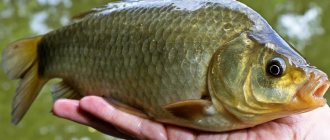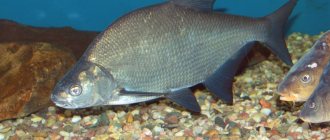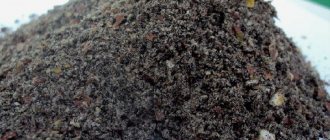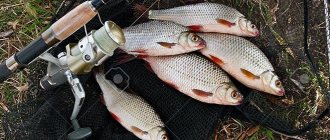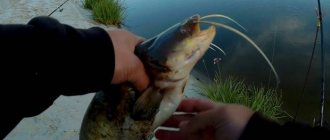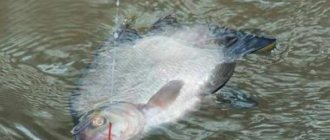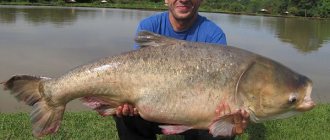Fishing for bream on a feeder in spring and summer on the river
When planning to catch bream with a feeder, you need to imagine the behavior of this fish in the reservoir of your choice: parking places, biting times, taste preferences of bream in a particular season of the year.
Most often, it is the bream that first begins to bite in reservoirs, as soon as the ice melts. This fish adapts most quickly to new conditions. And you can catch bream throughout the open water season until the very first ice.
The time for catching bream can only be discussed in relation to a specific body of water and taking into account weather conditions. No more weather-dependent fish! Only large crucian carp pays more attention to weather changes. And bream can even leave their usual place, fed for months, only because the atmospheric pressure has increased or the water level has risen slightly, or the degree of its transparency has changed.
Read also: Fishing calendar by seasons and months of the year
Therefore, catching bream, in general, and catching this fish using feeder equipment is an equation with many unknowns, each of which can affect the final result of fishing.
Where to catch bream
In the river, any peaceful fish (including bream) of medium and large size prefers to move along the channel edges, carefully examines dumps, entrances and exits to pits, places with slow or reverse flow, underwater large stones, as well as any places of shelter. In places where it is possible to find food, schools of bream appear at least once a day.
Milkers and floaters find such places and patiently wait for fish to emerge. Feeders have an advantage over other fishing methods. It lies in the fact that the angler can lure bream to the fishing spot and keep it in this place for quite a long time.
Fishing for bream with a feeder in reservoirs with a current is more effective. Because the current carries the bait down, informs the fish about the presence of food and lures the fish. In calm water bodies, feeder bait attracts the attention of fish in a limited area of the bottom.
Where to catch bream on a feeder
When choosing a location, you should give preference to large bodies of water . Before you start fishing, you need to study the area. The photo below shows edge A. Territory B is the best place for fishing. B – bites in this zone near the pit are less likely.
- Using the “mirror reflection” principle. The steep bank is deeper than the flat bank. A deeper place upstream is selected.
- Study the bottom topography using markings and measure the depth.
- Study a body of water through observation. The passage of the school is visible from the fins at the surface of the water.
In addition to knowing the bottom topography, it is necessary to take into account the habits of the fish and the most frequent feeding places. They should not have a strong flow or abundant vegetation. Acceptable depth and hard bottom. Three main places:
At the exit from the pit. In the pit itself, the fish feels vulnerable, so a bite is more likely at the exit.
Edge edge. The river current carries food particles to the edge.
Terrace behind the edge. Due to the movement of water, settled food is thrown onto the terrace thanks to eddy currents.
The choice of depth is important , since the temperature of the water and its enrichment with oxygen depend on it. During the day, these factors change, and the bream migrates through the reservoir. During the day, the bite occurs more often at a depth of 4-12 meters, at night 2-9 meters.
Choosing a place to catch bream
You should start searching for a suitable place by studying the bottom. On reservoirs without a current, you can use a standard (purchased) or homemade depth gauge to measure depths. If possible, you can explore an interesting area of the reservoir using electronic devices.
In reservoirs with a current, the exact depths are more difficult to determine, but you can study the bottom topography using the techniques used in spinning fishing. To do this, it is enough to conduct the load several times evenly or stepwise. The tension of the fishing line and the impact of the weight on the bottom can tell an attentive fisherman about the nature of the bottom, about the drops and rises.
Read also: Echo sounders for fishing. Which to choose?
In order to identify all interesting bream sites from the point of view of potential sites, you will need:
- feeder rod equipped with a reel with fishing line wound on a spool,
- the load is sufficient so that it is not carried away by the current;
- an alcohol marker that allows you to leave marks on the fishing line.
Usually on the river, anglers choose a distant channel dump to cast feeder equipment. And on reservoirs without a current there are pits or tables. Any changes in the bottom topography are of interest to bream.
Feeder equipment for bream
Feeder fishing always requires thoroughness. The fishing area must be equipped. You will need a flat surface for a fishing chair or high chair.
You need several rod stands - at least 2 pieces. When fishing for bream, especially if bites from large fish are possible, a landing net is vital for the fisherman.
Naturally, the fisherman must be dressed for the weather.
Feeder rod
Equipment for bream is standard equipment for a feeder rod.
It is best to choose a fishing rod made of carbon fiber (carbon) with a tip test of 80-120 g. This test is explained by fishing in the current, because bream is a deep-sea river fish. You will have to make long casts to successfully catch large specimens.
More experienced anglers should use a “fast” action blank. Beginners should pay attention to the “medium” and “slow” tuning. This is explained by the technique of throwing large feeders over a long distance.
When fishing for bream on a feeder on a river in spring or summer, the length of the rod should be at least 3 meters. The optimal rod length is considered to be 3.3-3.6 meters.
So, let’s summarize which blank rod to use when fishing for bream with a feeder on the river in summer or spring:
- Length - 3.3 meters;
- The action of the rod is fast;
- Rod test - Heavy Feeder “Heavy” up to 150 grams;
- Replacement tip test - (for fishing conditions: current strength, casting distance - feeder weight) - from 60 to 120 grams.
Feeder reel
The reel is usually used inertia-free, equipped with at least five metal bearings.
The reel spool can be straight or tapered. If you have to cast gear over long distances, then it is better to choose a spool with low sides.
Reel for fishing with a bream feeder:
- Inertialess;
- Coil size from 3000 to 4000;
- The mass of such a coil will be approximately 400 grams;
- The rear clutch is more convenient;
- Gear ratio 4.5:1 or 5:1. The gear ratio of the feeder reel number 5 indicates that the line layer will make 5 revolutions (skeins per spool) with one revolution of the handle. Such reels have proven themselves on the positive side in terms of quality and suitability for feeder fishing.
When catching large bream, a baitrunner is a good idea. When the baitrunner is turned on, the fish will unwind the line from the spool under tension, which will prevent it from getting off and dragging the rod into the water.
Line or cord
The spool can be wound with a monofilament line made of polymer materials or braided line. The thickness of the fishing line must correspond to the fishing conditions.
On the river, it is more advisable to use braided fishing line to reduce its windage in the water. The optimal diameter of the main line can be considered 0.18. This diameter has a breaking load of at least 12 kg, which is more than enough. Many bream feeders use a shock leader to reduce cord friction under high loads when casting bait with a feeder. The length of the shock leader is 2 times the length of the rod being used.
Read also: How to tie fishing line with braid
Feeder feeder
Feeder feeders in feeder fishing are consumable material, like hooks. There should be several types of them in stock (various weights, shapes, volumes). For the middle course of the river, using the gear described above, the initial weight of the feeder can be considered 40-60 g, optimal 60-90 g.
Leash
It is better to make a leash from monofilament, at least 50 cm long, with a cross-section of at least 0.16 mm.
The cross-section of the leash can only be reduced in crystal clear water, but this will increase the possibility of a break and a fish coming off.
Hook
The hook must match the size, color, and bend of the main bait and the size of the fish that you plan to catch.
Athletes are advised to use smaller hooks when catching bream on a feeder in the summer on the river. A small hook is easier to disguise with bait and the bream is more likely to swallow it and get hooked. Often small things constantly get caught on a small hook and bait; if you increase its size and bait, then the small things will bother you less, but bites from large fish also become more careful and rare.
At the same time, a small hook can simply fly out of the mouth of a large fish when hooking, especially if the bait is tight, even with the sting open. This is why many amateur fishermen prefer to use a larger “normal” hook, even at the expense of its concealability. Others, on the contrary, do not see the dependence of the size of the hook on the size of the fish.
In general, we can give the following recommendations for selecting a hook for bream when fishing on a feeder:
- If bloodworms are used as a bait for bream, then the optimal size will be No. 16-14;
- Maggots can be attached one at a time or several at a time; it is better to choose a hook for catching bream No. 14-10;
- For corn, pearl barley, mastyrka, hominy, you can take medium sizes: No. 14-8;
- For the worm, you can choose a medium or long forend with No. 10-6.
Installing feeder equipment on bream
Some fishermen mount the equipment directly on the main line, making knots and limiting the movement of the feeder with a stopper. Other feeder hobbyists make ready-made elements at home, using different thicknesses of fishing line and making several types of rigs. Crimping tubes can be used instead of knots.
A lot has been written about feeder equipment. We advise you to read about the types of feeder rigs here and about the feeder rig for catching bream on the river and the Gardner Paternoster Reservoir.
Watch the video of feeder rigs for catching bream on the river in summer - the best feeder rigs:
Preparing gear and choosing equipment for catching bream on a feeder
It is necessary to assemble the gear correctly in order to cover all the necessary fishing conditions, be it a river with a current, or a small lake. For example, fishing for bream with a feeder in a current requires choosing a more powerful rod, but for a lake a light feeder or even a picker is also suitable. Let's discuss the assembly of the gear in more detail.
Which feeder to choose
When selecting a fishing rod, we take one feeder for the reservoir, and another for the river. I won’t even talk about several feeders for different distances. For a large reservoir, the so-called “catapult stick” is suitable in common parlance, a long, long-range feeder. Feeders with a height of 3.9 and 4.2 meters are suitable, but feeders with a height of 3.6 are also suitable, and the universal test for such conditions is 100 grams of lead. For fishing on small lakes, a feeder with a length of 3.3-3.6 meters and a weight of up to 90 grams will be sufficient.
It will be easier with a river, and any feeder for bream can be used, within reason, of course. I like poles up to 120 grams, in heights of 3.6 and 3.9 meters. I’ll say right away that first of all, select a feeder that suits your wallet, and don’t forget about spare parts and quivertypes.
I think we’re done with feeders, we took as a basis an amateur who is not ready to spend a lot on fishing, but at the same time wants to catch the coveted bream. An example of such a feeder would be Volzhanka Optima 3.9, Zemex Iron 3.9, Black Hole Huper 3.9, with various test indicators.
Coil selection
Flagman Force Active 5000 reel
The reel also plays an important role when equipping a feeder rod for bream. The main thing is that it is reliable at a crucial moment. After all, situations on the river are different, the treasured trophy will visit everyone, it’s a matter of approach and time. Since we are fishing at long ranges or in strong currents, we will need a high-torque reel. Reels with a gear ratio of 4.7.1 are suitable, but this does not mean that only those will do. For example, I use reels from Flagman, specifically Force Active in size 5000. They have been working for the second season, and for a second this is more than a hundred fishing trips a year.
Options for feeder equipment for bream
Let's go over the feeder rig for bream, and since I often participate in sports competitions, I fish with only one permitted rig - In-Line. They are also called Raning Rig, the differences between them are minor. With such equipment, bream can easily survive in the event of a break or shooting of the tackle, which is humane to the fish. Probably everyone pulled out old grandfather’s springs from the water, on which underwater inhabitants were already in different conditions.
In-Line is a sliding feeder installation, and it will take one minute to do it. To do this, you will need a swivel with a carabiner and one small bead, preferably black. Installation can be improved with a tap. When retracting, the installation is practically not confused. It is better to make a bend from twisting a thicker fishing line (0.22 - 0.30 mm) or it is worth using beaded rubber if fishing is carried out on thin leashes.
Sometimes I still use montages such as paternoster, helicopter and two knots. Installing a paternoster will be the easiest and most effective for fishermen who are just starting to master feeder fishing for bream. Such equipment for bream shows every bite, and most importantly, it is “self-hooking”, that is, the fish sits on the hook on its own. All that remains is to throw the tackle, but this does not always happen.
In a paternoster, the main thing is to catch the moment with the hanging loop, the loop should be below the level of the feeder, then there will be much less confusing moments.
A helicopter and two units - this option for feeder equipment is not the simplest, but not complicated either. In my opinion, such an installation for a feeder will be extremely effective only in strong currents, and I would not recommend that amateurs start with it. Paternoster and In-Line are much better suited for catching bream.
We recommend reading
How to catch bream on a fishing rod with a float and assemble the gear Catching bream on a fishing rod is an exciting fishing activity that attracts the float angler primarily by its size...
Line or cord depending on fishing conditions
When assembling feeder gear for bream, I use both fishing line and cord, but in different conditions. It is better to fish with fishing line at short distances, during periods of negative temperatures, in the summer when there is an abundance of poplar fluff, and also in the spring when there is a strong flood. It is worth considering that the fishing line stretches well and it is difficult to break through it, so I want to pay attention to special feeder fishing lines. I use fishing lines from Dunaev Feeder Match.
Line Dunaev Feeder Match
The cord will be relevant at any time; it is difficult to replace it with fishing line, so it is better to purchase a cord first. I don’t recommend beginners to take thin diameters, I think 0.12 - 0.14 mm is enough, but cheap Chinese cords “plus” a lot and it’s worth making allowances for this.
Choosing a feeder on a river and reservoir
In fishing stores, the choice of feeders is huge, we’ll take a look and weed out what you need and what you shouldn’t take. We immediately abandon square feeders, and take round ones in their place. If we are considering feeder fishing on a reservoir, and specifically the long range of 50–60 meters, it is worth purchasing “nozzles” and “Serbian bullets” because of the shifted center of gravity, they fly well even in strong side and head winds. Suitable weights from 40 to 80 grams, different feeding capacity.
For the river, heavy-duty feeders with lugs are suitable, which are very useful in strong currents. The weight range of bream feeders depends on the strength of the current, namely 60 - 140 grams. Feeder feeders are a consumable item, and you don't need to worry too much about a few feeders that will remain on the bottom of the river. I tear them off often and it's part of the process, if you can call it that.
Still have questions about assembling gear or fishing tactics? Feel free to ask our expert questions and you will definitely get an answer from a professional. Ask a Question
Feeder leashes and hooks
The feeder equipment for catching bream must include a leash. Prepare leashes in advance at home, for example, in a leash for a feeder, or you can tie them on a regular sponge. It is better to select the optimal leash length and hook number directly on the pond. This choice depends on the period of activity of the fish, species composition, size of the fish, bait and much more.
At the reservoir I use leashes 30-50 centimeters long, this is enough for catching bream and bream. When catching bream with a feeder on the river, it becomes more and more difficult, and I start working with leashes 70 centimeters long, sometimes the length reaches one and a half meters, but the most universal leash is considered to be one meter long.
Prepared leashes
The diameter of the leader line is selected individually. I successfully catch bream on fishing lines with diameters of 0.09, 0.10 mm, but this requires skill and breaks are inevitable when fishing with such diameters. I recommend starting with 0.12 mm, maximum 0.14. You shouldn’t overuse thick fishing lines; this can lead to a small number of bites or no bites at all. I like Team Dunaev and Colmik Xilo leader line .
Hooks for the feeder are also selected during the fishing process; for catching bream, I like: Owner 53101, 53100, 50921, 50922.
Bait for catching bream on a feeder
Nowadays, it is not so difficult to buy bait mixtures labeled “feeder” or “bream” in the store.
The difficulty is that the seller can offer several types of such baits, with different properties. In addition to bait, the seller will definitely offer a flavoring agent. When catching bream on a feeder in the spring or summer, it is best, of course, to make a small supply of bait by purchasing several bags of a commercial mixture with different properties and select a suitable one on the pond or even create a mixture of several baits. Sometimes this works great on unfamiliar bodies of water.
Read also: The best bait for bream with your own hands
You need to be careful with flavorings. In cold water, fragrances can repel fish. In summer it's a different matter. In late spring and summer, bream favors aromas such as bloodworm, dill, garlic, vanilla and anise. You can try “sweet flavors”: caramel, strawberry, banana...
Their use can also attract carp, carp, and barbel.
The following can be used as bait filler for bream:
- millet,
- barley,
- wheat,
- corn and peas.
The main requirement for feeder bait is that it must be completely washed out of the feeder. Therefore, it cannot be over-moistened at the time of mixing.
For kneading, a container is used - a plastic or folding cloth bucket and a mixer.
Summer bream fishing on a feeder. What does an angler need to know for maximum results?
Among the huge variety of fish species, bream occupies a special, honorable place. This is not surprising - the fish grows to large sizes, is distributed almost everywhere, bites greedily and actively resists when fished. All this contributes to the emergence of more and more “bream fishermen” - people specializing specifically in bream fishing. However, despite its wide distribution in the reservoirs of central Russia, catching a large bream weighing more than one and a half kilograms is not such an easy task, and seducing fish larger than three rubles with your bait is a real fishing success. However, during certain periods, which include the beginning of summer - the time of post-spawning feast - fish are caught quite well and are often found in fishermen's catches.
When looking for a place for good bream fishing, you should adhere to the following principles. Firstly, you should immediately exclude the maximum depths of the reservoir. As the water warms up in shallow places, the rapid development of microorganisms begins, which constitute the main diet of fish at this time of year. If we talk about river fishing, then fish should be looked for in runs with an average depth of 2-2.5 with a gentle current. Direct runs at the entrances and exits of pits are excellent for fishing, where, after a difficult reverse flow, the river stream levels out. As a rule, in such places it is somewhat smaller than in the pit itself, therefore, in addition to bream, all white fish are common here - roach, silver bream, ide. Tricky streams are also interesting places to fish. Swirls and breakers on the surface indicate that the bottom in such places is not level, there is debris, driftwood, and stones, and the different flow rates of individual jets indicate the presence of an edge. In such places, a lot of food carried by the current lingers, so the fish stay here constantly.
You should not ignore all kinds of bays and pools with reverse currents and practically stagnant water. As a rule, the maximum depth is observed in the pools, so fishing on a hot day in such places is not a wise decision. It is much more effective to fish the border between the pool and the main stream - in such places, in addition to bream, there is also a chub, known for its brutal bites with turning over the rod.
Excellent places for fishing are areas located next to the rifts - both before and after them. As a rule, the stream hitting the stones washes out decent depressions right in front of them, where large fish like to stay. In addition, 90% of the riffles end in a drop into a decent hole, where there is a relatively weak current and food is excellently retained. One of my favorite bream places on the river is a hole with an average depth of 3.5 meters, located between two riffles. The bottom in the fishing area is composed of rocks and pebbles, and there are also quite large boulders. Judging by the nature of the bottom relief, in this place there should be chubs with ides, but bream dominated the catches, and there were actually trophy specimens over two kilograms, and once luck smiled on me and “gave” a bream weighing 3160 grams.
Night bream fishing is somewhat different from daytime fishing. For the most part, when choosing a place for night fishing, preference should be given to shallower places, with depths of 1-2.5 meters. Fish come out to such shallows to feed at night, and with dawn they again remain fishless. If there are holes, deep runs, and bays near these “shoals,” the chances of successful fishing increase many times over.
Particular attention should be paid to measuring the bottom and determining the bottom relief and the nature of the bottom. If we do not take into account sports fishing, when the athlete’s fishing zone is limited by the boundaries of the sector, in amateur fishing 70% of success comes from the correct choice of place. Therefore, measuring the bottom and “pulling” the marker weight along the bottom should be given exactly as much time as it takes to find a promising place. It may be a small pit, a riverbed edge, deposits of stones and pebbles. Even banal changes in the bottom soil often have a positive effect on the fishing result - the transition from sand to pebble bottom can be a promising fishing spot, not to mention colonies of shells that large bream simply adore.
There are two main ways to determine the nature of the bottom relief. The first is tapping the bottom using the jigging method. The sinker is selected with a weight that will allow you to record changes in the bottom topography based on the speed of the fall to the bottom. It should be remembered that a lead sinker sinks at an average speed of 1 meter per second, so changes in the bottom topography are clearly visible by the speed at which the sinker sinks - if the time of falling to the bottom increases, the sinking begins; if it decreases, the sinker goes aground. When the approximate topography of the bottom is clear, a marker weight is suspended on the rod and the nature of the bottom is examined with small broaches. Any changes are perfectly felt in the hand - if the bottom is rocky or there is shell rock, then slight trembling is felt. The load slides along the clay bottom as if on ice. If it moves jerkily, the bottom in the fishing area is silted and the load sticks. The load moves evenly along the sandy bottom, but with slight sticking. But the specific muddy or sandy bottom is of little interest to us; the most interesting areas are the transition of one type of soil to another - the transition from muddy to clay bottom, a strip of shell rock or stones among the sandy bottom, etc. It is precisely such areas that are of the greatest interest for fishing; it is at such local “points” that the maximum catches are made.
As for fishing in stagnant bodies of water, everything is somewhat simpler here, because there is no current that carries away food and interferes with the fishing process. At the same time, fish in lakes, as a rule, are much more passive and cautious, so you shouldn’t expect sharp river bites, which means it would be appropriate to use light and thin gear and small baits. As a rule, after spawning, lake bream does not leave the coastal zone of water bodies and feeds in thickets of aquatic vegetation, where fishermen catch it. A huge advantage of lake fishing is the possibility of attaching fish - for several days, food is placed in the fishing spot at the same time, collecting fish. By the time of fishing, the fish are accustomed to the constant appearance of food at a given point and are looking forward to the start of the “distribution” of food.
Another phenomenon that makes deep lake fishing pointless is the thermocline. Its essence lies in the fact that below a certain water horizon in the hot season, the water is almost completely deprived of oxygen, so the fish avoids such places and stays either in the surface layers of the water or in the coastal zone of reservoirs.
Night bream fishing on lakes is a separate topic for discussion. Unlike river fishing, it is much easier to catch an active bream bite at night in still water bodies. At night, bream, as in rivers, comes out to feed at shallow depths, up to half a meter, where fishermen expect it. The most effective gear in this situation would be a float rod for fishing directly at the edge of aquatic vegetation and a feeder for fishing far from the shore. In addition to bream, large crucian carp and tench are often caught at night, which makes fishing very varied. A huge advantage of night fishing is the almost complete absence of small fish at the fishing point, which makes it possible to hunt exclusively for trophy fish. Very often there is a situation when, in a fishing spot during the day, it is not possible to catch anything except small roach and laurel - so greedily and frantically does the small thing attack the hook with the bait. And with the onset of night the situation changes - the little things no longer bother you and rare bites bring only “bonus” fish. But as soon as dawn breaks, the large fish leaves the fishing point, and its place is again taken by the ubiquitous little things.
When fishing for bream, special attention should be paid to the bait mixture. Many fishermen may be skeptical about this phrase - they say, porridge works great! However, do not forget that in warm water the porridge will immediately turn sour, scaring away the fish from the fishing point. According to underwater hunters with whom I spoke, in popular bream places in the summer the bottom is practically covered with sour porridge, and there is practically no fish in such places.
Complementary food for catching bream should be heavy, inert, and contain a large amount of large fraction. Various floating particles are extremely undesirable; they attract all kinds of small fish to the fishing spot. To prevent the bait from becoming dusty, it should be moistened in several stages and given a slightly larger amount of water than usual. It will be useful to add rolled oat flakes, they perfectly “glue” the mixture together, and when mixing, add molasses - sweet beet molasses - to the water. In addition to excellent “adhesive” properties, it gives the bait additional aromatization and taste, which has a positive effect on the fishing result. All these tricks are done with the goal that after casting the bait spreads like an even carpet along the bottom and does not “dust” excessively.
Another important point is the presence of a large faction. Fine-grained bait compositions are good at attracting fish to the fishing point with the help of their aromatics and mechanics, but they are not able to retain them for a long time. Bream is a fish that loves to eat. It is for this purpose that all sorts of large particles are added to the bait - crumbly undercooked millet, peas, canned corn and corn grits. An excellent additive is “pechivo” - ground crackers, painted in bright colors, which can be either industrially prepared or perfectly made at home. Traditionally, all sorts of animal components - food bloodworms, maggots, cut worms - are excellent at attracting fish to the fishing point. Since they are quite expensive, they should not be added once for the entire volume of bait, but in portions, into the feeder before each cast, constantly maintaining the maximum concentration at the fishing point.
Equally important is the aroma of the mixture. Today the market offers a great variety of flavorings – both specialized and food grade. From this variety, several aromas can be identified that work well for bream in almost all bodies of water - they are cinnamon, vanilla, caramel and coriander. The latter works great specifically for large bream; many ready-made bait compositions aimed at catching bream have a pronounced smell of coriander, and quite a strong one at that.
We should not forget that aromas can both attract fish to the fishing point and repel them. And if you scent the entire bait composition in advance and don’t get the smell right, then the fishing result can be sad. Therefore, during the fishing process, you should use a sports “trick” - mix the bait without adding extraneous flavorings, make it neutral, and during the fishing process, select one or another flavoring, add it directly to the feeder or before making balls and watch how the fish react to it .
The color of bait is a stumbling block and a subject of heated debate in the fishing community. There are two diametrically opposed opinions on this matter - some believe that the bright yellow spot of the bait attracts large fish with its appearance and therefore the bait is not darkened at all. Others, on the contrary, paint the bait black almost always and everywhere, arguing their point of view with the timidity and caution of large fish. As is usually the case, the truth is somewhere in the middle - when fishing at a depth of up to two meters, darkening the bait gives the fish a confident bite, it is not afraid of the spot and confidently approaches the bait. When fishing at a depth of over 2 meters, it is not at all necessary to darken the bait. In addition, you should pay attention to the color of the bottom soil - it is clear that black bait will stand out on a sandy bottom, just like yellow bait on a muddy bottom.
When going after large fish, you should have in your arsenal as large a list of baits and attachments as possible. It happens that throughout the day, fish appetites change dramatically. In this regard, bream, of course, is not such a “confused” fish as tench or crucian carp, but it also has its own “quirks”. For example, last year, in the very heat, the fish refused to bite on anything except bloodworms - which they ate with great pleasure. Demonstration fishing took place both for caddisfly and for canned corn. Therefore, you should not limit yourself to the standard set of “bloodworm\maggot\worm”; barley, corn, steamed peas, and “star” pasta would also be useful in the fish menu. If there is no bite on pre-stocked bait, it makes sense to look for something interesting in the coastal vegetation - caddisfly, goose, small brown leech - who knows what the bream needs now?
Tackle is selected based on fishing conditions, but overly delicate gear should be avoided - after all, the fish is quite large and strong.
When choosing a hook, you should first consider the attachment that will be used during the fishing process. If you need to highlight any optimal hook size, then it will be numbers 12 and 14 according to the international classification. Their size is sufficient to catch both with a medium-sized worm and with 2-3 bloodworms, if necessary.
There are no special criteria when choosing a feeder rod for catching bream. You should be guided by the general principles of choosing a fishing rod class depending on the fishing conditions and not use excessively heavy gear. For fishing in the current, it is preferable to use a braided cord - with it the feeder “drags” along the bottom much slower than with a fishing line. If we touch on the topic of fishing in still waters, then a simple principle applies here - if fishing occurs at a distance of up to 25 meters, it is appropriate to use high-quality monofilament. If further there is only a braided cord, the fishing line, due to its high stretchability, well conceals not only bites, but also the sensations of fishing.
Bream fishing is a very rewarding and interesting activity. When the line is pulled tight by a bowstring, and the dull shocks of a large fish are heard in your hand, when the rod blank bends and the drag sings its song, you understand - this is happiness! No tail, no scales!
Bait for bream
Bream is an almost omnivorous fish. In spring and autumn, it is better to equip the feeder tackle with bait - bait of animal origin. Bloodworms, maggots and red worms are rightfully considered the most popular.
In summer, baits that bream favorably regard include insect larvae, as well as baits of plant or artificial origin.
Vegetable baits for summer bream include seeds of grain and legumes. Lures of artificial origin are silicone bloodworms, crustaceans, as well as foam balls, which recently for some reason regularly interest not only bream, but also other large fish.
Do you want to catch a large bream on a feeder on a river in spring or summer! Fish House will share advice on what to use to catch bream on a feeder on the river. As everyone knows, bream, especially large ones, love large baits and lures. Any fish is also guided by aroma.
So, let's begin?!:
- choose hook No. 14;
- we thread one light maggot by the skin to the forend;
- Let's take garlic! thread a boilie (the size of a pea or in the form of a small tablet) (it is already on a thread, sold in packs of 30 pieces) until the maggot;
- put the second maggot on the hook;
- and finally a beautiful live worm.
This attachment helps out even in slow times. It is worth remembering that large bream bite well either after sunset or before 1 o’clock. Or from 3-4 o'clock to 7-9 o'clock.
Bait for the feeder for bream
This species of cyprinids has a surprisingly subtle sense of smell; bream smells food 200 meters away, and only when approaching does it use hearing and vision.
Therefore, when using complementary foods, you must take into account the aroma and color scheme. It is necessary to take it as a rule that the bait should not “go” with the flow. It must remain in a certain place. The consistency is thick and difficult to wash out. The following additives should be excluded:
- bran;
- hemp;
- coconut shavings;
- sunflower seeds.
Instructions for preparing complementary foods for bream:
- The mixture must be filled with water ten hours in advance, and not kept in light or heat.
- Add river soil from the bottom of the reservoir where fishing is planned or clay.
- The main part is the bait used by the fisherman.
- The maggot is first scalded with boiling water.
- When using attachments of plant origin, pearl barley or other additives are added to the complementary food.
Smell and color
Preferred scents:
- in spring you should choose sweet aromas of anise, vanilla plus bait;
- during the summer and autumn seasons - sunflower seeds, fruits;
- in cold winter the smell of pepper or pineapple.
Color options:
- in spring and summer yellow, red and green are used;
- In autumn and winter, the benefits of using dark colors (for example, brown) or red.
The most universal color is red. It is bright enough for use in any conditions. To be sure, you should take several different colors.
Strategy for catching bream on a feeder
Having figured out the casting point, you need to thoroughly feed the place. To do this, a high-capacity feeder is mounted on the feeder. Using this feeder, at least 10 portions of bait are sent to the feeding point.
If you are sure that a large bream will immediately be suitable for bait, then you can immediately add large fractions (corn, steamed wheat, peas) to the bait. If you are not so sure, you need to attract small fish to the fishing spot first. We add small fractions that create turbidity to the bait (millet, breadcrumbs, yogurt, semolina).
Only by creating a small but compact bait spot can you mount a “working” feeder, which you will equip with a bait mixture. The bait (or bait) is placed on the hook
Next, you need to cast to the baited area. Waiting for a bite – no more than 10 minutes. Then, regardless of the result, the tackle must be worn out, the feeder must be equipped with a new portion of the mixture and sent back to the feeding place.
Sooner or later, the bait carried downstream will attract the fish to the bait. From the moment of the first bite you need to be extremely careful. Following the small fish, after a while large fish approach the bait. The first sign is that the bites of small fish suddenly stop.
The tackle needs to be pulled out, large fractions added to the bait, and larger bait placed. You need to cast the tackle again, loosen the reel clutch in advance and wait for a bite from medium and large bream.
Catching bream on a feeder, secrets and subtleties
When using several rods, they must be positioned correctly. The first is installed at an angle of about 45 degrees to the shore, the second - about 75 degrees and the third - 105. This arrangement allows them to avoid getting tangled with each other.
In a fast current, the cast does not occur perpendicular to the river, but at a strong angle to reduce the pressure of the flow on the line.
The washout time for even viscous complementary foods is approximately 25 minutes; this is the maximum time after which it is worth re-casting. But it’s best to recast every 10 minutes, even if there are no bites.
Biting bream and catching it
The bite of a large bream on the feeder is reliable and confident. The top either sharply straightens, or just as sharply straightens.
The hook must be sharp. The fight even begins. Large bream do not give up without a fight. He tries to go to the center of the fairway, turn his body across the current and, using its strength, go as far downstream as possible.
You need to try to stop it with the movement of the rod. The friction clutch will allow the line to be pulled in jerks. Sooner or later the bream will get tired. It can be pulled closer to the shore.
You can only take bream in a landing net. Moreover, you need to act carefully. Even a weakened bream at the sight of a landing net can decide to make a “last push”, breaking off the leash with the hook.
Fishing for large bream should never be forced. The afterburner will not save time when fishing, but it will increase the chances of a break. And fighting close to the bait spot can scare away the fish standing there.
Take your time, and you will catch bream.
Catching bream on a feeder in spring and summer video
Fishing for bream on the river video
Catching bream and bream on a feeder on a river with the current video
TV channel "Hunting and Fishing"
Excellent morning bream bite
Bream on the feeder. Video report about fishing on the southern dam of the Gulf of Finland in St. Petersburg. The bream was actively biting on the feeder; the bream was especially active in the early morning, before 8 o’clock. After an unsuccessful trip, I finally decided to give revenge to the southern bamba. This time the weather was just great and the bream were biting constantly. I used maggot + worm as bait; I added chopped worm, maggot and boiled peas to the bait as additional components. I tested the Running Feeder Rig, a new rig for myself, on beaded rubber, I was very pleased with it, I will definitely be fishing with it in the near future.
Night fishing for large bream on a feeder video
Night bream fishing on the Sheksna River. The purpose of this fishing ball is night bream fishing, to try to catch bream at night and at the same time test a rig for feeder fishing called a running feeder rig. The night biting of bream began as soon as it got dark and continued with short breaks until 7 am, then the biting resumed from about 8 am until lunch. This fishing for bream turned out to be very productive, I did everything planned and caught a decent amount of large bream on the feeder. In the near future there will definitely be a second trip to this reservoir... Enjoy your viewing everyone.
Cod fishing gear
Fishing with bombard (sbirulino) >>
Feeder
The preferred feeder size is medium, square-shaped. Weight is selected from 70 to 90 grams (depending on the speed of water movement). The hook is taken in sizes from 14 to 10. It is recommended to use an asymmetrical loop as equipment.
There are two types of feeders - open and closed.
- The flat feeder is also open
Open - used for complementary feeding based on plant components, with a loose structure, from which the complementary feeding is washed out faster.
- Closed - perforated plastic used for live feeding.
Feeders come in a variety of shapes. Tips for using some of them:
- If you are fishing in the current, you need to take a flat feeder that fits well on the bottom. – For plant food, an oval shape is used.
- Using double feeders - with plant and live food - can be effective.
- If the depth is large, then a heavy feeder with loose food that leaves a trail when immersed is suitable.
Nozzles for catching bream on a feeder
When catching bream, both plant and animal baits are used:
- bloodworm;
- maggot;
- caster;
- peas;
- sweet corn from a can;
- pasta;
- boilies;
- pellets
It is allowed to mix nozzles and select several types at the same time.
